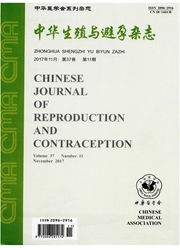

 中文摘要:
中文摘要:
目的:通过大鼠子宫内膜自体移植模型研究定坤丹治疗痛经及子宫内膜异位症(endometriosis,EMS)的疗效和相关机制。方法:将成功建模组大鼠随机分成5组,每组7只,模型对照组(B组)、孕三烯酮阳性对照组(C组)和定坤丹低剂量组(D组,相当于临床人用剂量)、中剂量组(E组,相当于临床人用剂量2倍)、高剂量(F组,相当于临床人用剂量4倍),并以5只假手术大鼠为正常对照组(A组),检测用药后血清雌、孕激素水平、异位内膜包囊数及异位内膜血管内皮生长因子/血管内皮生长因子受体(VEGF/VEGFR2)表达水平的变化。结果:定坤丹对大鼠血清雌、孕激素水平没有显著影响,但能显著抑制异位内膜包囊的生长,抑制率F组为63.9%±20.0%,E组为54.1%±22.1%,D组为51.9%±23.7%,与B组比,均有统计学差异(P=0.000);与C组(47.0%±45.0%)比无统计学差异(P〉0.05)。异位内膜VEGF/VEGFR2表达水平的免疫组织化学和免疫印迹分析结果显示,定坤丹治疗导致异位内膜分泌VEGF减少,异位内膜包囊壁基质中的VEGFR2下调,包囊壁上皮vEGFR2高水平表达。结论:定坤丹治疗能显著抑制异位内膜包囊的生长,VEGF/VEGFR2改变可能与异位内膜包囊壁上皮层的脱落和包囊腔的形成有关。
 英文摘要:
英文摘要:
Objective: To study the curative effects and involved mechanisms of Dingkundan to treat dysmenorrhea and endometriosis (EMS) with the rat model of endometrial autologous transplantation. Methods: Rats with the successful model operation were randomly divided into 5 groups, each group consists of 7 rats including model control group (group B), gestrinone group positive control group (group C) and Dingkundan low-dose group (group D, equivalent to clinical dose), middle-dose group (group E, equivalent to 2 folds of the clinical dose), high-dose group (group F, equivalent to 4 folds of clinical dose); and 5 rats with sham operation (group A) were used as control group. The observation and detection included the serum estradiol and progesterone levels, the growth of cysts of ectopic endometria and protein amounts of vascular endothelial growth factor/ vascular endothelial growth factor receptor (VEGF/VEGFR2) in the ectopic endometrial tissues. Results: No significant changes of hormone levels including serum estradiol and progesterone were found after Dingkundan treatments, but it was significantly inhibited the growth ofectopic endometrial cysts. The percent inhibition rate was 63.9%± 20.0% in group F, 54.1% ± 22.1% in group E, 51.9% ± 23.7% in group D, and groups of all doses were of statistical differences (P=0.000) compared with group B. However, compared with group C(47.0% ± 45.0%) there was no statistical difference (P〉0.05). The expression of VEGF/VEGFR2 in ectopic endometrium by immunohistochemistry and Western blotting analysis was found that Dingkundan treatment reduced significantly the secretion of VEGF in ectopic endometrium, and accompanied by the down-regulation of VEGFR2 in stroma of the ectopic endometrial cyst wall. On the other hand, the high level of VEGFR2 specific expression in epithelial layers of the ectopic endometrial cyst wall may be related to epithelial shedding and further to the formation of its wrapped cyst cavity. Conclusion: Di
 同期刊论文项目
同期刊论文项目
 同项目期刊论文
同项目期刊论文
 Inhibition of proprotein convertase 5/6 activity: potential for nonhormonal women-centered contracep
Inhibition of proprotein convertase 5/6 activity: potential for nonhormonal women-centered contracep Embryo implantation is closely associated with dynamic expression of proprotein convertase 5/6 in th
Embryo implantation is closely associated with dynamic expression of proprotein convertase 5/6 in th Effects of EG-VEGF, VEGF and TGF-beta1 on pregnancy outcome in patients undergoing IVF-ET treatment.
Effects of EG-VEGF, VEGF and TGF-beta1 on pregnancy outcome in patients undergoing IVF-ET treatment. Endocrine gland-derived vascular endothelial growth factor concentrations in follicular fluid and se
Endocrine gland-derived vascular endothelial growth factor concentrations in follicular fluid and se Knockdown of regulator of G-protein signalling 2 (Rgs2) leads to abnormal early mouse embryo develop
Knockdown of regulator of G-protein signalling 2 (Rgs2) leads to abnormal early mouse embryo develop The Influence of LepR Tyrosine Site Mutations on Mouse Ovary Development and Related Gene Expression
The Influence of LepR Tyrosine Site Mutations on Mouse Ovary Development and Related Gene Expression 期刊信息
期刊信息
